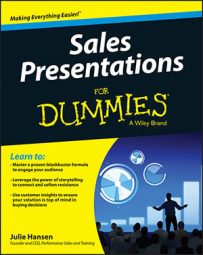A successful sales presentation must grab your prospect’s attention and make a compelling case for him to take the next step in the sales process. Winning presentations don’t happen by chance. Make sure your next sales presentation is designed to persuade and engage today’s busy decision makers by keeping the following checklists handy as you plan, build, and deliver your sales presentation.
A Planning Checklist for Your Sales Presentation
A sales presentation that is tailored to address your prospect’s unique needs and interests is a prerequisite for success. Use the following checklist to help you gather key information about your prospect and the opportunity.
The opportunity
___ Identify the opportunity.
___ Qualify the prospect.
___ Set an actionable goal.
___ Identify the challenge.
___ Discover the trigger event.
___ Determine the current solution.
The impact
___ Establish the impact of the problem.
___ Identify the impact of the solution.
___ Determine key performance indicators (KPI).
___ Confirm timing and expectations.
The competition
___ Identify the competition.
___ Research buying history.
___ Do a competitive analysis.
The logistics
___ Determine who will be at your presentation.
___ Agree on the format.
___ Establish the time and date.
___ Confirm the venue.
___ Make arrangements to set up.
___ Determine your travel needs.
The audience
___ Identify roles.
___ Get contact information.
___ Schedule discovery calls.
___ Conduct discovery conversations.
___ Define point of view and personal impact.
___ Confirm your audience’s decision-making process.
Using Hooks in Your Sales Presentation’s Opening
A hook is an attention-grabbing device that focuses your prospect’s attention on your message, sets the tone of the presentation, and provides something of value. Here are several types of hooks that ensure that your presentation starts on a strong note.
-
Quote: Using someone else’s words can add an element of credibility to your presentation or effectively frame your message. Example: “The secret of success is to do the common thing uncommonly well.” John D. Rockefeller
-
Question: Asking your audience a question can get them actively thinking about the topic and participating in the conversation. Example: What percentage of expense reports you process is error-free?
-
Startling statement: Opening with a strong point of view can be effective at getting your audience to sit up and pay attention. Example: “You may be losing half a million dollars or more a year by not being able to take advantage of early supplier payment discounts.”
-
Fascinating fact: An interesting fact that is relevant to your topic can incite curiosity and conversation. Example: The fastest growing segment of the population is those individuals 80 and older.
-
Story: A short relevant story is a unique and powerful way to open a presentation. Example: “My recent zip line experience reminded me of the business challenge we’re here to discuss. Here’s why…”
-
Prop: An object can give your message a powerful visual impact. Examples include flipchart, whiteboard, book, phone, key.
-
Insight: Sharing something valuable about your prospect’s industry or company can enhance your credibility and greatly improve attention. Example: “We discovered that your accounting personnel typically touch a document four times before it gets processed in your current system.”
-
Video: A short on-point video is a sure way to gain attention and set the tone for your presentation. Example: A company selling security technology uses a quick montage of news clips on personal information leakage.
Making Sure You Have the Right Tools for Your Sales Presentation: Your Performance Tool Checklist
Your sales tools aren’t limited to your PowerPoint slides and projector. Used effectively, your voice, body, and movement can bring your presentation’s message to life and add impact. Follow the guidelines here to make sure that you’re using your voice, body, and movement to their highest potential.
Voice
____ Volume
____ Cadence
____ Emphasis
____ Clarity
____ Use of pauses
____ Variety
____ No filler words
Body
____ Gestures
____ Open body language
____ Eye contact
____ Facial expressions
____ Confident stance
____ Relaxed body
____ Authentic
____ Congruent to message
Movement
____ Tied to purpose
____ Tempo
____ Sit or stand
____ Appropriate for room size
____ Set props
Designing Your Slides for Your Sales Presentations
The best slides tell a story, but that story can get miscommunicated or lost on your prospect if your presentation slide is unclear or difficult to read. Subject each slide in your deck to these guidelines to make sure that you’re using your valuable real estate wisely.
-
Keep one message per slide.
-
No more than six lines of text.
-
Choose images that create an emotional connection.
-
Create simple graphs for statistics.
-
Keep to a consistent color palette.
-
Avoid tired templates and create your own look.
-
Limit animated transitions and builds.
-
Use contrast colors in background.
-
Use dark type on a light background.
-
Feature 18-point type so text is easy to read at a distance.
-
Load up the white space.

